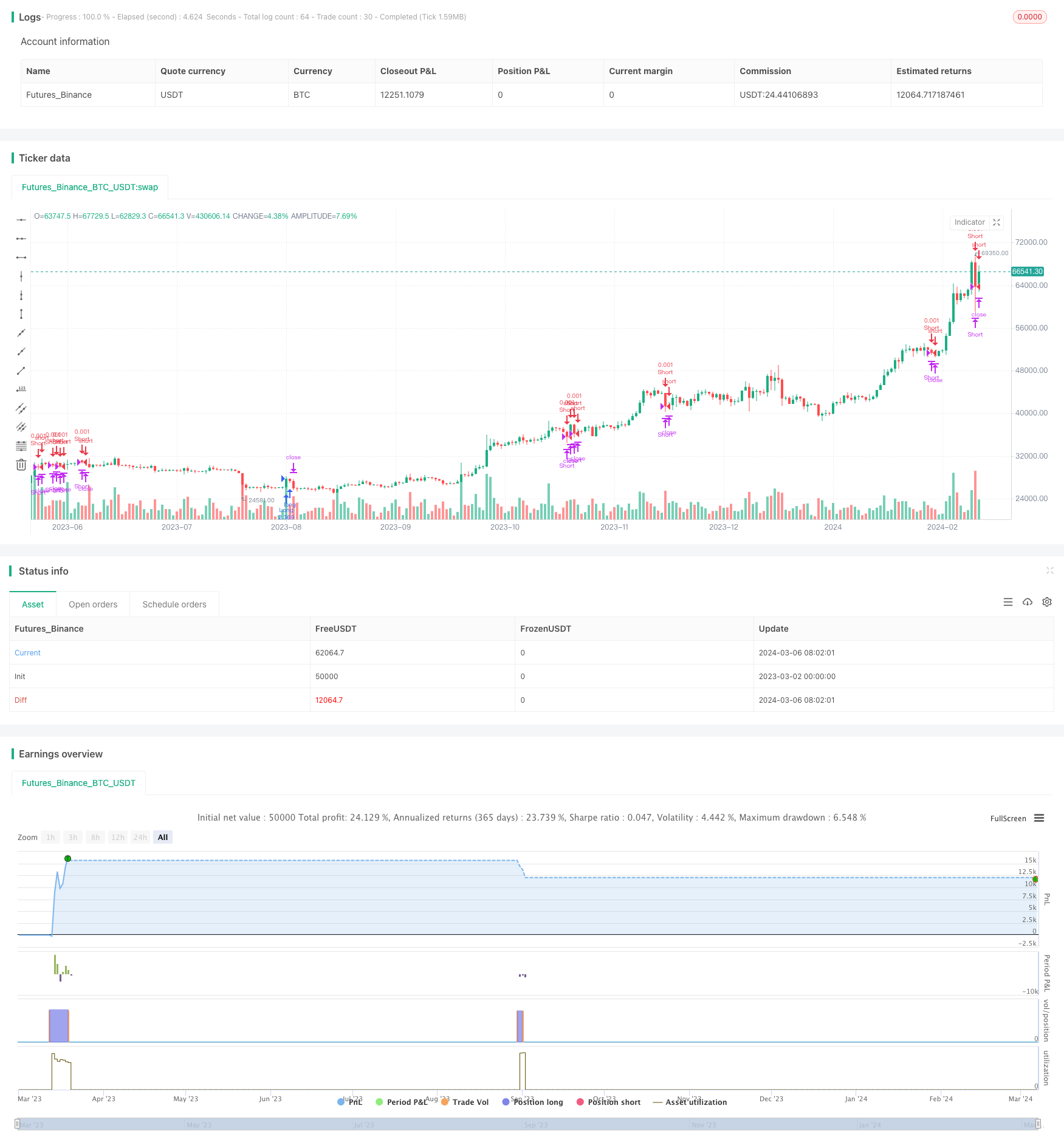基于相对强弱指数(RSI)与止损的多头量化交易策略
Author: ChaoZhang, Date: 2024-03-08 15:06:58Tags:

概述
本文介绍了一种基于相对强弱指数(RSI)与止损的多头量化交易策略。该策略利用RSI指标判断市场超卖和超买状态,在超卖时开多头仓位,超买时平仓。同时,策略采用百分比止损来控制风险。这是一个经典的趋势追踪策略,旨在捕捉强势市场中的上涨趋势。
策略原理
该策略的核心是相对强弱指数(RSI)。RSI是一个动量振荡指标,用来衡量一段时间内价格的变化幅度。其计算公式为:
RS = N天内上涨幅度的平均值 / N天内下跌幅度的平均值
RSI = 100 - 100 / (1 + RS)
其中,N为计算RSI的时间周期,通常取14。
策略的逻辑如下:
- 计算N周期的RSI。
- 当RSI从下向上突破超卖水平(如30)时,开多头仓位。
- 当RSI从上向下突破超买水平(如70)时,平掉多头仓位。
- 在开仓时,根据当前价格和设定的百分比,计算出止损价格。
- 如果价格触及止损价格,则平掉多头仓位,控制损失。
该策略试图在市场由熊转牛初期开仓,牛市末期平仓,以捕捉主要上涨趋势。
优势分析
- 简单易用:该策略只使用了一个技术指标RSI,逻辑清晰,适合初学者学习和使用。
- 趋势追踪:策略在超卖区开仓,超买区平仓,符合”低买高卖”的趋势投资理念,可以有效捕捉牛市上涨趋势。
- 风险控制:百分比止损可以帮助投资者控制每笔交易的风险敞口,将损失限制在可接受范围内。
风险分析
- 振荡市亏损:RSI是一个滞后指标,在震荡市会发出较多错误信号,导致频繁开平仓,积小损成大损。
- 止损位设置不当:若止损位设置过宽,单次损失较大;若止损位设置过窄,会过早止损,错失后续趋势。
- 仓位管理欠缺:策略缺乏对仓位的动态调整机制,风险敞口控制不够灵活。
优化方向
- 趋势过滤:在使用RSI信号前,先通过长期均线或其他趋势指标判断大趋势,只在大趋势向上时使用RSI多头信号。
- 止损优化:可以考虑使用移动止损或ATR等更高级的止损策略,动态调整止损位置,使其更贴合市场节奏。
- 仓位管理:根据市场波动性、趋势强度等因素,动态调整每笔交易的仓位大小,以更好地控制风险。
- 多空对冲:在使用多头策略的同时,引入空头策略进行对冲,降低策略的整体风险敞口。
总结
本文介绍了一个基于RSI与止损的多头量化交易策略。该策略利用RSI超卖超买信号开平仓,同时使用百分比止损控制风险。这是一个简单实用的趋势追踪策略,适合初学者学习。但其也存在一些局限性,如震荡市表现不佳,止损和仓位管理欠缺灵活性等。针对这些不足,我们可以从趋势过滤、动态止损、仓位管理、多空对冲等方面对策略进行优化,以期获得更稳健的收益。量化交易策略的开发是一个不断优化迭代的过程,需要投资者在实践中不断总结经验,调整完善。
/*backtest
start: 2023-03-02 00:00:00
end: 2024-03-07 00:00:00
period: 1d
basePeriod: 1h
exchanges: [{"eid":"Futures_Binance","currency":"BTC_USDT"}]
*/
//@version=5
strategy("RSI Strategy (Long)", overlay=true, initial_capital=1000, default_qty_type=strategy.percent_of_equity, default_qty_value=100)
length = input( 14 )
overSold = input( 30 )
overBought = input( 70 )
price = close
vrsi = ta.rsi(price, length)
co = ta.crossover(vrsi, overSold)
cu = ta.crossunder(vrsi, overBought)
// *** Signals ***
enter_long = ta.crossover(vrsi, overSold)
enter_short = ta.crossunder(vrsi, overBought)
close_long = ta.crossunder(vrsi, overBought)
close_short = ta.crossunder(vrsi, overBought)
// *** Risk management ***
entry_price = close
percent_diff = input(5)
stop_loss_price_long = (1 - percent_diff / 100.) * entry_price
stop_loss_price_short = (1 + percent_diff / 100.) * entry_price
// *** Positions ***
if enter_long and strategy.position_size == 0
strategy.entry("Long", strategy.long)
strategy.exit("SL Long", "Long", stop = stop_loss_price_long)
if enter_short and strategy.position_size == 0
strategy.entry("Short", strategy.short, qty=.001)
strategy.exit("SL short", "Short", stop = stop_loss_price_short)
if close_long
strategy.close("Long", "Exit Long")
if close_short
strategy.close("Short", "Exit Short")
更多内容
- 基于VWAP和OBV RSI指标的BabyShark交易策略
- 比特币动量跟踪止损策略
- 基于多阶段布林带和MACD指标的量化交易策略
- MACD均线多头量化交易策略
- 甲易炳量化趋势动量交易策略
- 基于移动平均线的突破交易策略
- 波林格带突破与波动率过滤策略
- 双均线交叉策略-EMA9/20
- 动态自适应趋势交易策略
- 基于随机指标交叉的双向止盈止损策略
- 1-2-3 形态与 EMA、MACD 和第四根蜡烛线延伸的量化交易策略
- 基于21日EMA、成交量和RSI的趋势动量策略
- 基于双均线交叉和止损策略的高效交易策略
- 基于布林带均值回归策略
- 最高最低价格止损策略
- 基于RSI指标的双向交易策略
- SSL通道与绿量策略
- 基于双均线交叉量化策略
- 基于移动平均线和超级趋势指标的双重过滤指数基金策略
- 布林带突破回归交易策略